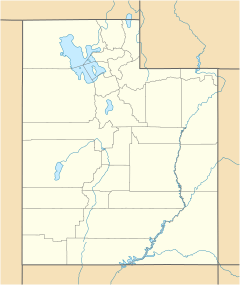Lapoint, Utah facts for kids
Quick facts for kids
Lapoint, Utah
|
|
|---|---|
| Country | United States |
| State | Utah |
| County | Uintah |
| Named for | Southward "point" of the Uinta Mountains |
| Elevation | 5,568 ft (1,697 m) |
| Time zone | UTC-7 (Mountain (MST)) |
| • Summer (DST) | UTC-6 (MDT) |
| ZIP codes |
84039
|
| GNIS feature ID | 1429476 |
Lapoint is a small community in Uintah County, Utah, in the United States. It's called an "unincorporated community" because it doesn't have its own local government like a city or town.
About Lapoint
Lapoint is located along State Route 121. It's found inside the Uintah and Ouray Indian Reservation, west of Vernal. Vernal is the main city in Uintah County.
A stream called Deep Creek, which flows into the Uinta River, runs through Lapoint. The community is about 5,568 feet (1,697 meters) above sea level. Even though it's not a city, Lapoint has its own post office and a ZIP code of 84039.
Lapoint was first named Taft, after William Howard Taft, who was a U.S. President. Its name was later changed to Lapoint. This new name comes from the fact that the community sits on a "point" or spur of the Uinta Mountains that juts southward.
Climate
Lapoint has a semi-arid climate. This means the area usually gets very little rain or snow. It's often dry, but not quite a desert.
Famous People from Lapoint
- Lane Frost (1963-1989) was a world champion professional rodeo bull rider. He was very famous for his skills and is now in the Hall of Fame for rodeo.
- Shawn Bradley is a German-American former professional basketball player. He played as a center for teams like the Philadelphia 76ers, New Jersey Nets, and Dallas Mavericks in the National Basketball Association (NBA).
Archaeological Discoveries
Lapoint was built on top of an important ancient site called "Caldwell Village." This site belonged to the Fremont culture, an ancient group of people who lived in Utah.
In 1966, archaeologists explored the site. They found 22 pit-houses, which were homes dug partly into the ground. They also found pits, hearths (fireplaces), and even ancient irrigation ditches. Many artifacts were discovered, including pottery pieces, stone tools, and items made from bone and shell.
Scientists believe people lived here between 1050 and 1200 AD. Today, you can't see any remains of Caldwell Village on the surface. This is because farming over many years has covered or destroyed the ancient structures.



